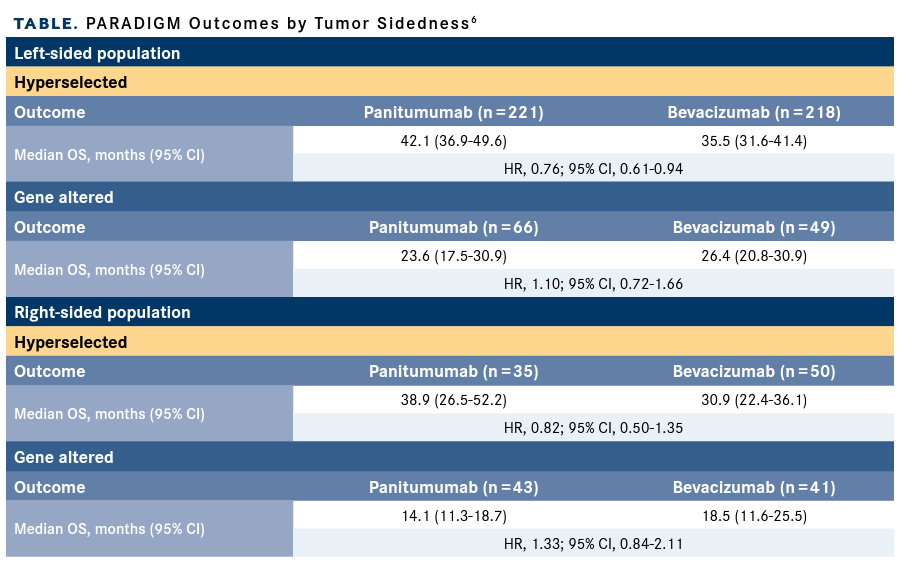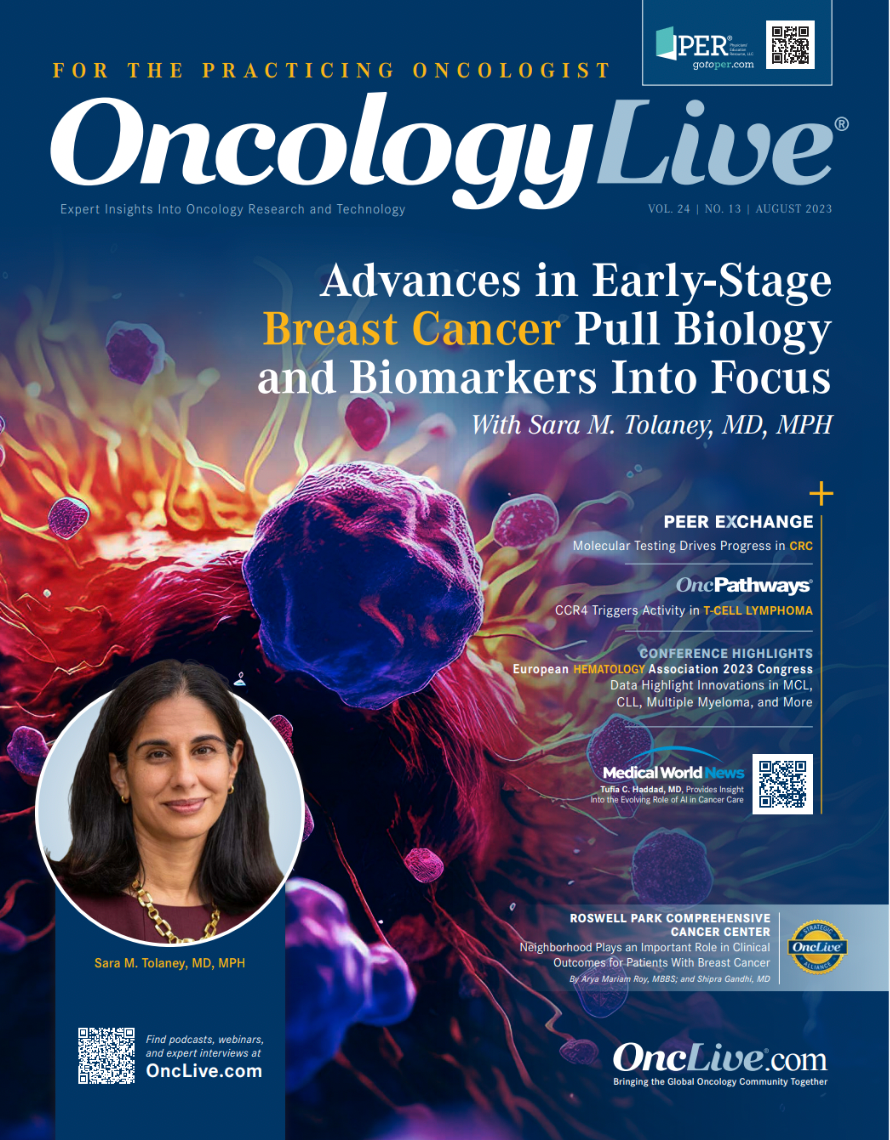News
Article
Oncology Live®
Molecular Testing Drives Progress in CRC
Author(s):
Emerging strategies leveraging biomarker data for the treatment of patients with early-stage and metastatic colorectal cancer have made precision medicine a top-of-mind topic for gastrointestinal oncologists.
John L. Marshall, MD

Emerging strategies leveraging biomarker data for the treatment of patients with early-stage and metastatic colorectal cancer (CRC) have made precision medicine a top-of-mind topic for gastrointestinal oncologists. “We have medicines that are very specific…increasing immunotherapy options, increasing precision medicine options; it’s a little more complicated than it was before,” John L. Marshall, MD, said in a recent OncLive Peer Exchange®.
Marshall moderated the OncLive Peer Exchange discussion during the 2023 American Society of Clinical Oncology (ASCO) Annual Meeting. In the discussion, a panel of leaders in GI oncology unpacked the latest developments in BRAF V600E–mutated disease as well as the use of circulating tumor DNA (ctDNA) and minimal residual disease (MRD) in the management of metastatic CRC in the first half of the program.
The panel had a specific focus on the available guidance and data concerning testing and implementing these strategies to guide decision-making in the clinic. “We are in a time where we have the benefit of having a lot of specific inhibitors, some [available] in standard practice, some on trial, but we really want to start and parcel off some of these rare molecular subgroups and give them therapies that probably work a lot better than our cytotoxins,” Stacey A. Cohen, MD, said.
However, Cohen noted that the first step for any treatment decision is to consider all options and not jump right to targeted therapy. “It’s a fun time because you have so much leverage on what you do. You get to think about all the different options. You get to have a discussion with patients. But that’s also an uncomfortable space because there’s not one right way to do it. It comes down to guiding the discussion based on the information that you have, figuring out what other information you need, and then trying to move the plan forward. First, I’m thinking about a patient. If they [have] metastatic [disease], you’re going to have [to] pause and say: Is this someone who [has] widely metastatic [disease], or do we have the chance to think about this as oligometastatic [disease that is] potentially curable, potentially resectable, especially if it’s [metastatic to the] liver only? We’re going to be thinking about this in a multidisciplinary fashion, even in stage IV.”
For those patients with widely metastatic disease, Cohen said she would proceed to leveraging molecular markers to guide treatment. With turnaround times becoming an ever-present hurdle, Cohen noted that at the first meeting she sends liquid biopsy samples out on the day she meets with patients. “The first thing that we need to know is whether [a patient has] microsatellite instability [MSI], because we know that those patients should be on first-line immunotherapy. We’ve [started] recognizing that MSI-high [MSI-H] cancer is a different disease, and we need to flag that those patients absolutely need immunotherapy if it’s not contraindicated.”
Clinical guidelines state that all patients with CRC should undergo reflex testing for MSI-H or mismatch repair–deficient (dMMR) disease.1,2 “After that, we’re looking at KRAS, NRAS, BRAF, HER2, [or] anything else that we think might be a driver mutation. And not just do they have one of those mutations, but what is the specific mutation?”
A Walk Down the BRAF Pathway
In CRC, BRAF mutations are mostly focused on the point mutation, BRAF V600E, which has presented a unique therapeutic opportunity to enhance clinical outcomes for patients. “When we mention BRAF, we’re really focused on the V600E mutation,” Cathy Eng, MD, FACP, said. “It’s involved in the RAS and MAPK pathways. We understand that it’s pretty rare, [appearing in] approximately less than 10% of our patient population, roughly 9%, but the fact is that it is a poor prognostic indicator for overall survival [OS] for our patients. The good news is that we have a drug that we can use for these patients.”
The BRAF V600E inhibitor encorafenib (Braftovi) is approved in combination with the EGFR inhibitor cetuximab (Erbitux) based on data from the phase 3 BEACON CRC trial (NCT02928224).3 Eng noted that encorafenib needs the support of cetuximab unlike other cancers where the agent has demonstrated efficacy as a single agent. Marshall concurred, adding, “[In CRC], you can have a perfectly good marker, you block it, and all [the disease] does is go around it. It’s sort of swampy; you block 1 river, but it just swamps its way around. In almost all [treatments for CRC], we need to hit these pathways more than once.”
Despite the success seen with encorafenib, it is only an option in the second-line setting, to which Marshall posed the question of what can be done in the first line. “Clinical trials. There are first-line clinical trials, and we’ve started to see some of those data combining with chemotherapy with BRAF-targeting therapy in the first-line [setting in CRC],” Aparna Parikh, MD, MS, said.
Eng noted that testing for BRAF to inform eligibility for trials is also vital. “We have other clinical trials that are focused on the BRAF mutation, and doctors [should be] familiar and comfortable with ordering BRAF testing. We encourage it because that information is extremely critical to making a decision about whether patients are going to go on a newly diagnosed, BRAF-mutant, metastatic [disease] trial or are going to just receive standard of care and proceed to [BRAF inhibitors] in the second-line setting.”
One of the ongoing studies in the first-line setting is the BREAKWATER trial (NCT04607421) evaluating the efficacy of the encorafenib/cetuximab combination in the first-line setting.4 “The reasoning for this is, as we learned from BEACON and as we’ve seen with the phase 2 ANCHOR-CRC [NCT03693170], that there’s a potential larger benefit as we move these agents to earlier lines of therapy,” Tanios S. Bekaii-Saab, MD, FACP, said. “It makes sense. You hit biology early, you’re going to have your best benefit.”
The study is enrolling patients with metastatic BRAF V600E–mutant CRC who have received no prior therapy for metastatic disease and have measurable disease per RECIST 1.1 criteria. Prior treatment with a BRAF or EGFR inhibitor or known MSI-H/dMMR status is prohibited. Patients will be randomly assigned 1:1:1 to encorafenib plus cetuximab, encorafenib/cetuximab plus modified FOLFOX6 (folinic acid, fluorouracil, and oxaliplatin), or modified FOLFOX6/FOLFOXIRI (folinic acid, fluorouracil, oxaliplatin, and irinotecan)/CAPOX (capecitabine and oxaliplatin) with or without bevacizumab (Avastin). The study will also include a separate cohort of patients who will be randomly assigned 2:1 to encorafenib/cetuximab/FOLFIRI (folinic acid, fluorouracil, and irinotecan) or FOLFIRI/bevacizumab.4
Primary end points are progression-free survival and overall response rate (ORR) between the encorafenib/cetuximab/modified FOLFOX6 arm and the FOLFOX6/FOLFOXIRI/CAPOX with or without bevacizumab arm. The primary end point in the separate cohort is ORR.4
“The first data that came out from BREAKWATER from the lead-in studies looked incredibly promising, with FOLFOX [looking a] little more promising with FOLFIRI. But the choice was to proceed with FOLFOX primarily based on pharmacokinetic parameters,” Bekaii-Saab said.
In terms of testing for trial enrollment, Bekaii-Saab and Cohen noted that improving outcomes requires fast turnaround of results to match patients with optimal care. For example, the BREAKWATER study requires BRAF V600E confirmation on either blood or tumor tissue testing.4 “One of the good aspects of this study, and one that’s actually a good lesson for drug development, is that the sponsor of the study has done a great job allowing us to act on liquid biopsies, given the high component rate,” Bekaii-Saab said. “In fact, the first 2 patients from my clinic who went on this study were found to have their BRAF V600E mutations on liquid biopsy [results], which certainly have facilitated access. We have to move fast, especially in the United States. There’s no waiting.”
Cohen noted an experience in her clinic that has also changed her practice: “What prompted us to start doing liquid biopsy is that I had a patient whose results came back later on a tissue sample [positive for BRAF V600E], and I realized it was a missed opportunity. We want to always be offering these opportunities to patients, especially for those with poor prognostic disease.”
Sidedness vs ctDNA
Although testing for mutations tackles one part of the diagnostic battle, tumor sidedness has also been cited as a means for determining. Data have demonstrated that outcomes with systemic treatment vary based on whether the tumor is located on the left or right side of the colon.5 For instance, the right side of the colon is associated with MSI-H disease and BRAF, KRAS, and PI3KA mutations, and tumors from this side typically do not benefit from EGFR inhibitors. Left-sided tumors are more common and have demonstrated benefit with EGFR inhibitors.5
However, at the 2023 ASCO Gastrointestinal Cancers Symposium, Shitara et al presented findings from the PARADIGM study (NCT02394795) on how ctDNA can aid in the guidance of hyperselection of patients for treatment rather than tumor sidedness. “We’ve learned over the years of the prognostic differences between the sidedness [and] started to understand the first-line differences of anti-EGFR therapy for the patients [with] right-sided [tumors],” Parikh said. “The dogma has moved toward approaches stating that patients [with] right-sided [tumors] don’t benefit from anti-EGFR therapy. But it’s more [complex] than that, and there is a subset of biomarkers present in selected patients.”
Investigators of PARADIGM looked at hyperselected patients, defined as those with alterations identified in ctDNA that confer resistance to EGFR, such as KRAS, NRAS, BRAF V600E, PTEN, EGFR ECD, HER2 and MET amplifications and ALK, RET, or NTRK1 fusions.5 “These are what you would think would portend resistance to anti-EGFR therapy,” Parikh said. “Even on the right-sided [tumors], if you don’t have those biomarkers that will predict lack of benefit, they’re patients who benefit. To have kept [decision-making] as simple as just [considering] sidedness is bad. It’s why I like liquid biopsy for patients.”
Parikh said that she would not select patients with right-sided tumors for EGFR inhibitors in the first-line setting but would consider it in later-line settings. “I think there might be biomarkers, such as ctDNA, that can help us figure out whom those patients are who may or may not benefit.”
Findings from PARADIGM showed that using ctDNA to hyperselect patients with CRC with unresectable, chemotherapy-naïve, RAS wild-type disease from the overall population for treatment with either panitumumab (Vectibix; n = 258) or bevacizumab with modified FOLFOX6 (n = 271) resulted in longer survival outcomes with panitumumab than those who presented with gene alterations. The median OS in the hyperselected population was 41.3 months (95% CI, 37.1-48.1) in the panitumumab group vs 34.4 months (95% CI, 31.3-40.3) in the bevacizumab group (HR, 0.75; 95% CI, 0.62-0.92).6
The median OS in the gene-altered cohort of patients was 19 months (95% CI, 14.8-23.0) with panitumumab (n = 110) vs 22.2 months (95% CI, 19.1-27.7) with bevacizumab (n = 94; HR, 1.14; 95% CI, 0.84-1.54). Investigators then stratified patients by tumor sidedness in the hyperselected and gene-altered analyses (Table).6
Table. PARADIGM Outcomes by Tumor Sidedness6

“[Treatment] should be more fluid than defined, strict buckets of right and left,” Bekaii-Saab said. “This was beautifully done and justifies the importance of getting these liquid biopsies first.” He added that differences between liquid and tissue sampling may need further investigation because there are subgroups of patients who may not experience difference based on the type of sample. Marshall added that this is likely due to tumor shedding.
“The liquid [biopsy result] is giving you a sum of all tumors, and there’s some level of heterogeneity, whereas with tissue, you’re just hitting 1 [sample], which is probably accurate for [approximately] 85% of the patients. But for 15%, we’re missing the bigger picture at the beginning,” Bekaii-Saab said. “But we’re moving in a good direction in terms of understanding the interplay of these various mutations, alterations, and amplifications in CRC.”
As for the future of ctDNA in routine practice to determine pathways of adjuvant treatment for those who have resectable disease, Cohen noted that a study she and her colleagues performed highlighted the earliest timeline of testing post surgery.7 “At the 2023 ASCO GI [Cancers Symposium], we presented some information on cell-free DNA [cfDNA] and how that influences our detection of ctDNA,” Cohen said. “As much as we’re talking about the end results, the logistics [of testing] here are key. We’ve hinted at differences with tissue testing vs blood testing, but it all comes down to when that patient make[s] it into your clinic and how timely [you can perform testing] in relation to surgery. We’re looking at a 4- to 8-week window for adjuvant therapy. If we’re going to start incorporating ctDNA into our common testing strategies, we need those results and we need them as soon as we can get them.”
Tumor shedding after surgery may affect levels of ctDNA in patients post surgery; therefore, tumor-informed testing was conducted to assess the earliest window for ctDNA testing vs standard. “What our study did using the Signatera assay was to see when we can start sending that out [for accurate ctDNA analysis],” Cohen said. “We know that tumor-informed test [results] take a little longer [to come back].”
Within the first 2 weeks of surgery, an increase in cfDNA levels was observed, and this time 30.6% of patients showed a positive result for ctDNA. These rates were consistent with those observed during the standard MRD testing window of weeks 4 to 8 post surgery. Therefore, investigators concluded that standard MRD testing windows could be as early as 2 weeks after surgery or on day 15.7
“This is key, because if we knew a patient was going to surgery, we could order tissue profiling to be done maybe even before they went to surgery, and we could get that blood draw 2 weeks later,” Cohen said about practice translatable to the clinic. “We could cut down some of the turnaround time for the tumor-informed assays…. This will help us start thinking through some of these processes on an individual institution level.”
References
- NCCN. Clinical Practice Guidelines in Oncology. Colon cancer, version 2.2023. Accessed July 15, 2023. https://www.nccn.org/professionals/physician_gls/pdf/colon.pdf
- Dedeurwaerdere F, Claes KB, Van Dorpe J, et al. Comparison of microsatellite instability detection by immunohistochemistry and molecular techniques in colorectal and endometrial cancer. Sci Rep. 2021;11(1):12880. doi:10.1038/s41598-021-91974-x
- FDA approves encorafenib in combination with cetuximab for metastatic colorectal cancer with a BRAF V600E mutation. FDA. Updated April 9, 2020. Accessed July 15, 2023. http://bit.ly/3KysLlt
- Kopetz S, Yoshino T, Kim TW, et al. BREAKWATER: an open-label, multicenter, randomized, phase 3 study, with a safety lead-in (SLI), of first-line (1L) encorafenib (E)+cetuximab (C)±chemotherapy (CT) vs standard-of-care (SOC) CT for BRAF V600E-mutant metastatic colorectal cancer (mCRC). J Clin Oncol. 2023;41(suppl 16):TPS3627. doi:10.1200/JCO.2023.41.16_suppl.TPS3627
- Mukund K, Syulyukina N, Ramamoorthy S, Subramaniam S. Right and left-sided colon cancers - specificity of molecular mechanisms in tumorigenesis and progression. BMC Cancer. 2020;20(1):317. doi:10.1186/s12885-020-06784-7
- Yoshino T, Watanabe J, Shitara K, et al. Panitumumab (PAN) plus mFOLFOX6 versus bevacizumab (BEV) plus mFOLFOX6 as first-line treatment in patients with RAS wild-type (WT) metastatic colorectal cancer (mCRC): results from the phase 3 PARADIGM trial. J Clin Oncol. 2022;40(suppl 17):LBA1. doi:10.1200/JCO.2022.40.17_suppl.LBA1
- Cohen SA, Kasi PM, Aushev VN, et al. Kinetics of postoperative circulating cell-free DNA and impact on minimal residual disease detection rates in patients with resected stage I-III colorectal cancer. J Clin Oncol. 2023;41(suppl 4):5. doi:10.1200/JCO.2023.41.4_suppl.5
























%20(2)%201-Recovered-Recovered-Recovered-Recovered-Recovered-Recovered-Recovered-Recovered-Recovered-Recovered-Recovered-Recovered-Recovered-Recovered-Recovered-Recovered-Recovered.jpg?fit=crop&auto=format)
%20(2)%201-Recovered-Recovered-Recovered-Recovered-Recovered-Recovered-Recovered-Recovered-Recovered-Recovered-Recovered-Recovered-Recovered-Recovered-Recovered-Recovered-Recovered.jpg?fit=crop&auto=format)
